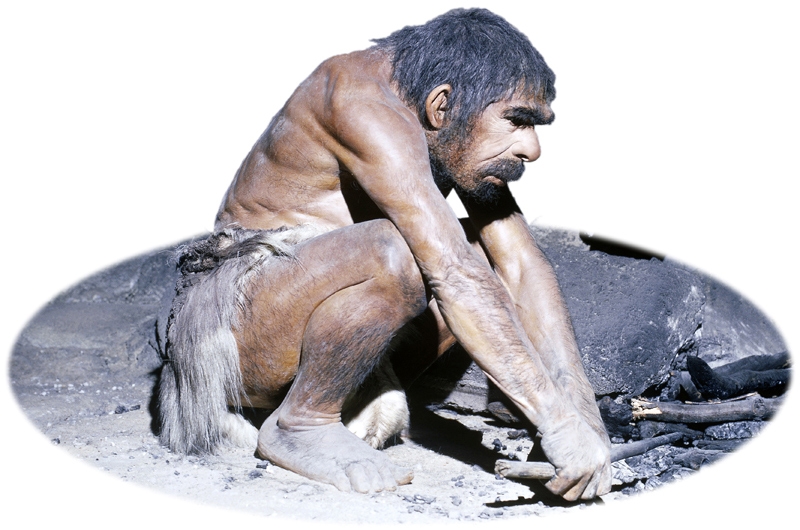The human species that today makes astounding advances in technology, and particularly in the medical field, did not exist four million years ago. In fact, hominids of that period were very different from the modern species in many ways. How did humans evolve to become today’s humans? How did Homo sapiens become so innovative? For one, they developed favorable qualities that were essential for adaptation and a thriving existence.

Homo sapiens derived from a form of early humans called Neanderthal. Unlike modern humans, characteristics of the Neanderthal included occipital buns and protruded brow ridges.1 One important facial feature of the Neanderthal was their large nose for “humidifying and warming cold, dry air” before it reached the lungs.2 Modern humans do not have this characteristic due to the fact that the Neanderthals lived in much harsher conditions. Thanks to the work of archaeologists and anthropologists, we know a great deal about the life and world of Neanderthals. The first fossils of these humans were found in France, and scholars have since called these humans Cro-Magnon. They created innovative tools from bones and antlers for hunting. This enabled them to survive and thrive in their environment. They even created artwork “in the form of decorated tools, beads, ivory carvings of humans and animals, clay figurines, musical instruments, and cave paintings.”3

Homo sapiens originated from East Africa. From there homo sapiens have migrated to all of earth’s main land masses. By taking advantage of land bridges, they have spread to Indonesia, New Guinea, Australia, and the Americas. Another contributing factor to the spreading of humans was the recent major Ice Age. The freezing of the oceans’ waters around the polar caps lowered the sea level, which exposed land bridges between land masses that were otherwise under water. For example, the connection between Calabria and Sicily had a sea level around -126 meters.4 They were able to adapt to the different environments due to their larger brain capacities, hence more intelligence. Having the knowledge that they had, they were able to create warm clothes and shelters to survive under various harsh conditions in the regions they occupied. Since they were nomadic people, there was no economic prosperity during the Paleolithic era. This was due to the fact that they never inhabited an area for a long duration of time. They were foragers; they scrapped up whatever they could find for survival, so there was no time period in which they could accumulate wealth. With that being said, that meant that there were no social classes. Instead, they lived an egalitarian lifestyle. While the men hunted, the women gathered. This method sustained their existence until the Neolithic Revolution, which domesticated both plants and animals.
The evolution of earlier hominids to Homo sapiens opened the door to a species capable of more advanced thinking about their surroundings and survival. The human race has since continued to thrive to the present. Without their innovative tools, body structures, and eventually domestication of plants and animals, Homo sapiens would not have been able to produce the advancements in technology and sciences that we have available today.
- Markus Bastir, Paul O’Higgins, and Antonio Rosas, “Facial Ontogeny in Neanderthals and Modern Humans,” Proceedings of the Royal Society B: Biological Sciences 274, no. 1614 (May 7, 2007): 1125–32. ↵
- Todd C. Rae, Thomas Koppe, and Chris B. Stringer, “The Neanderthal Face Is Not Cold Adapted,” Journal of Human Evolution 60, no. 2 (February 2011): 234–239. ↵
- “Evolution: Humans: Origins of Humankind.” Accessed September 10, 2016. http://www.pbs.org/wgbh/evolution/humans/humankind/o.html. ↵
- Fabrizio Antonioli, V. Lo Presti, M. G. Morticelli, M. A. Mannino, Kurt Lambeck, Luigi Ferranti, Catriona Bonfiglioli, et al., “The Land Bridge between Europe and Sicily over the Past 40 Kyrs: Timing of Emersion and Implications for the Migration of Homo Sapiens,” Rendiconti Online Societa Geologica Italiana, 2012. https://openresearch-repository.anu.edu.au/handle/1885/71477. ↵



99 comments
Cherice Leach
How interesting is it to learn something about where we originated from! It is cool to see that homo sapiens have always been innovative creatures. Even in the Paleolithic era, homo sapiens were creating tools that improved their means on survival. It is also interesting to bring up the reason why Neanderthals had such big noses. I never thought that a nose could change the temperature of air that was going in and that’s pretty cool!
Matthew Rios
I think it’s marvelous that we can all sit here and bask in the human past together in such a way that no other species can. We’ve come so far from bronze age beliefs, but still not far enough if you ask me. I found the regards to Neanderthals pretty interesting, their evolutionary traits are astounding. It begs the question what humans will look like thousands of year from now.
Rebekah Esquivel
This article provided very good information about the beginning of the human race. I was unaware that humans originated from East Africa and that the first human fossils were discovered in France. I also didn’t know about the occipital bun and large nose differences. I always thought people just had different shaped noses as a different facial feature not something to be better fit in a certain environment. I am very interested to see how much humans have changed since the time of Neanderthals and really makes me wonder how much more we will change over the course of my lifetime and beyond.
Alondra Aviles
This article is capable of breaking many misconceptions of the neanderthal population, it clearly explains the adaptions created biologically by these evolved species. The changes created biologically in the population present back then evolved into what we see around us, humans. Humans are now capable of intense thinking and adapting and it would be arbitrary not to say it wasn’t because of the necessary evolution neanderthals underwent. The article was very informative and contained the necessary details that rid our past ancestors of their stereotype.
Karina Nanez
Absolutely incredible, I hadn’t known that Neanderthals had larger brains than us making them smatter and able to adapt to different environments quickly. I also never would have guessed that they decorated their tools with beads and bones. This article really makes our close ancestors more relatable and diffidently more human, and it really is fascinating that the broad noses were meant to humidify and warm cold air before it reached the lungs.
Khoa Tran
Very interesting tittle, I had to read it twice to figure what “race” are you trying to say. It is fascinating to know that four millions years ago, people created artwork and musical instrument. This proved that us human loves art and music since the beginning. This make me wonder how much exactly have us evolved from our ancient ancestor. And also, can egalitarian life style be practical in today society? If yes, at what cost? Thank you very much for a very informative article.
Aaiyanna Johnson
Thanks for the extensive information given. It brought about a new perspective of our ancestors. I knew about them, but I did not know they developed occipital buns which would enable their advancement to grow further. By living through their experiences and gaining knowledge, they were able to sustain life. By doing this they were able to make life better for generations, whether they knew it or not.
Ezequiel De La Fuente
Such an interesting read! How different physically and mentally we are to our ancestors, but at the same time, somewhat similar. I had no idea that their noses were shaped in such a way for such a specific reason. I also liked reading about their journey as well and how the Ice Age allowed passages across land masses. Thankfully we have planes now!
Maria Callejas
Very creative title and great introduction! Starting your article by asking several questions excites the reader to find the answers. You do eventually respond accordingly. I enjoyed your Neanderthal insight, prior to talking about homo sapiens. That way, readers understand where modern humans come from and their evolutionary changes. Furthermore, you provided factual information that expanded my understanding of how early humans populated the earth (Especifically your Calabria and Sicily land bridge example).
Alexis Renteria
Very interesting and well written article. The way the article was written helped visualize what the human race went through in order to adapt to harsh climates and evolve. I found it interesting how much humans changed from hunting to domesticating animals and farming and now to creating new technology that we use on a daily basis. It goes to show how much we are capable of and the amazing things we can accomplish in the future.